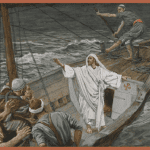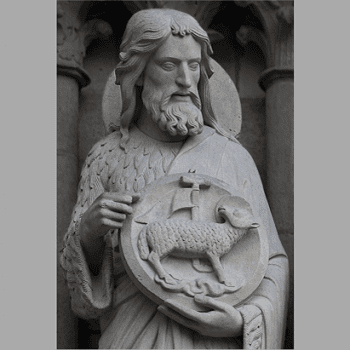
I have previously written about the Lord’s Baptism and posted it elsewhere with the title, “Baptism Made Jesus Dirty.”
Last Sunday, January 12, was the Feast of the Baptism of the Lord, with the Gospel reading taken from Matthew. This Sunday, January 19, the Gospel reading from John also presents the Lord’s Baptism. I’ll speak here below about the third “epiphany.”
In less than one hundred eighty years after the resurrection of Christ, there was already a yearly festival on January 6 to commemorate his Baptism at the Jordan River.
Within her first five hundred years, the Church had developed the chain of celebrations of the birth of Christ, the visit of the magi to the newborn in Bethlehem, his Baptism in the Jordan River, and his first miracle at the Cana wedding.
At one time or another, all those festivals were called Epiphany, meaning manifestation, revelation or even apparition.
We are in Year A of our three-year cycle of readings at Sunday Mass. In Year C, after the Solemnity of Epiphany the next feast is that of the Baptism of the Lord, and then, on the Sunday after that, the Gospel of the Cana wedding miracle.
Today we usually think of the solemn feast of Epiphany as commemorating only Christ’s manifestation or epiphany to the magi, the first pagans to venerate him.
But the early Church acknowledged with it the two other epiphanies: one to the Jews and one to the first Christians.
The epiphany to the Jews: in their presence, the epiphany of Christ receiving baptism from John the Baptist at the Jordan River.
This was also the first epiphany of the Trinity in history:
- heaven opening over God the Son on earth,
- the voice of God the Father acclaiming the Son,
- and the testimony of God the Spirit overshadowing him with the sign of a dove.
The epiphany to the first Christians: in their presence, an epiphany of Christ’s glory through the first of his miracles, the changing of water into superabundant, superior wine.
The Gospel says, “Jesus did this as the beginning of his signs at Cana in Galilee, and so revealed”— literally epiphanied— “his glory, and his disciples began to believe in him.”
This beginning of faith among his first disciples, the first Christians, was a beginning in many other ways.
This beginning of Christ’s miracles appears in John’s Gospel that starts with the same words as the book of Genesis, “In the beginning.”
The Gospel is a new Genesis.
In the old book of Genesis, at the first meal in Scripture, the first groom and bride impoverished and saddened themselves by disobeying God in eating what he had forbidden.
In the newer book of the Gospel, a new husband and wife in Cana are at their first married meal, but fall into unexpected impoverishment and sadness: the wine runs out.
At that point the mother of the Lord steps forward.
She appears in this Gospel only twice: here at Cana and again at Calvary.
In both places, Christ calls her, “Woman.”
Here at Cana, she is already the first believing disciple of Christ— before the faith of other disciples has even begun.
She does three things for the newly impoverished and saddened newlyweds.
First: she notices they are in need.
Second: she prays to her Son, telling him the plight of the poor and sad.
Third: with faith, knowledge and obedience, she tells those serving her Son to “Do whatever he tells you.”
At the Garden of Eden, the first woman gave the first man what God had forbidden, thereby telling the man not to serve God, but, as it were, to do whatever the snake said.
At Cana, the Gospel’s First Woman, the mother of the Lord, overturns the words of the first woman of Genesis by telling those serving Christ to do whatever he says.
In Eden a banquet of sin; in Cana a banquet of obedience!
Following his mother’s concern, the Lord tells the servants what to do.
However, before his mother spoke to the servants, he said to her: “Woman, how does your concern affect me? My hour has not yet come.”
Later in the Gospel, when his hour came at Calvary, he called his mother “Woman” for the second time, and he united her concern with his own.
In the hour of his cross, with concern for his mother and his disciple, he said, “Woman, there is your son,” and to his disciple, “There is your mother.”
From his cross, he renewed his poor mother as a mother by giving her a new son; and he renewed his poor disciple as a son by giving him a new mother.
More beginnings, more epiphanies!
At the cross, they had no wine, just as at Cana.
Rather, at the cross they had vinegar, which is wine gone bad.
At Calvary, the Lord’s mother could have said what she said at Cana: “They have no wine.”
However, at Calvary she is silent.
Her Son’s concern is to drink all the ruined wine of humanity, and she accepts that wordlessly.
With immeasurable thirst and poverty that swallowed all human poverty, the Lord Jesus drank the vinegar of Calvary.
With that, he summed up everything, saying, “It is finished.”
Calvary and Cana echo each other.
The beginnings at Cana say something about what the Lord finished and fulfilled at Calvary.
At Cana, the stone jars altogether held somewhere between one hundred twenty and one hundred eighty gallons of water.
The Lord turned all of it into superior wine.
Poverty became overflowing abundance and surpassing goodness.
Marital sorrow became a honeymoon with one hundred twenty to one hundred eighty gallons of excellence and joy!
From Calvary the bereavement of a mother and a disciple turned into their new life as mother and son; death turned into resurrection; suffering into glory.
Like Christ’s mother and the servants at Cana, we all have roles to play in his epiphanies.
If we take notice of need as his mother did, if we intercede as she did, if we exhort to service as she did, if we do whatever he tells us as they did at Cana, and if we go to Calvary as did his mother and a beloved disciple, then the Lord will work joyful signs and abundant superior beginnings.
“Jesus did this as the beginning of his signs at Cana in Galilee, and so revealed his glory, and his disciples began to believe in him.”
Everyday let us choose to begin to believe and serve.
Turn. Love. Repeat.
I mentioned above:
I have previously written about the Lord’s Baptism and
posted it elsewhere with the title, “Baptism Made Jesus Dirty.”
Here’s why “elsewhere.”
I am a freelance writer in California. A California law forbids media organizations such as Patheos to publish more than 35 individual works per year of a freelance writer residing in California without hiring that writer as a salaried employee. So as not to exceed 35 articles per year, I will post articles here at Patheos about once in every 10 or 11 days.
Between my postings here at Patheos, I will make “extras” available at a personal blog: Monk Notes.











